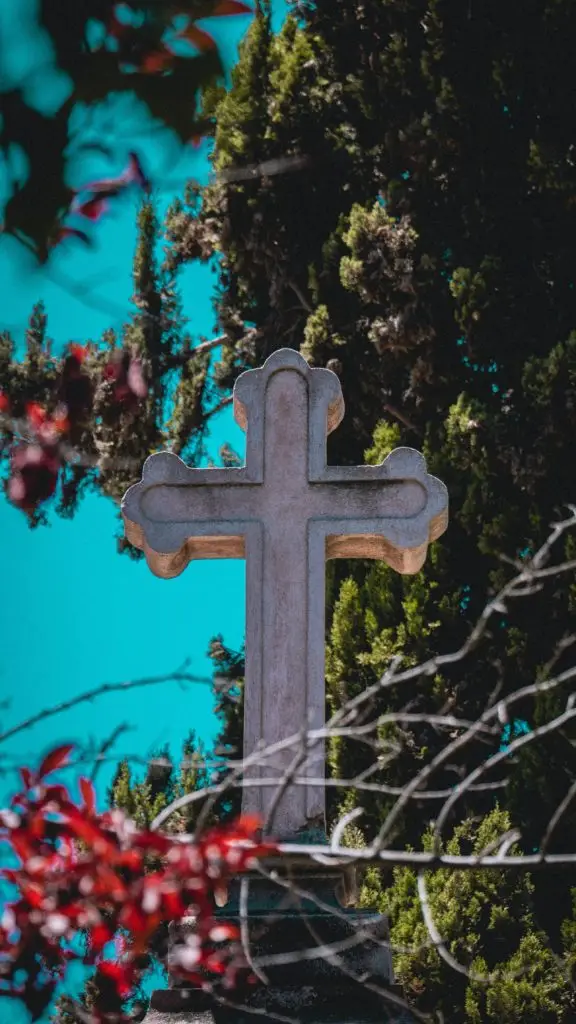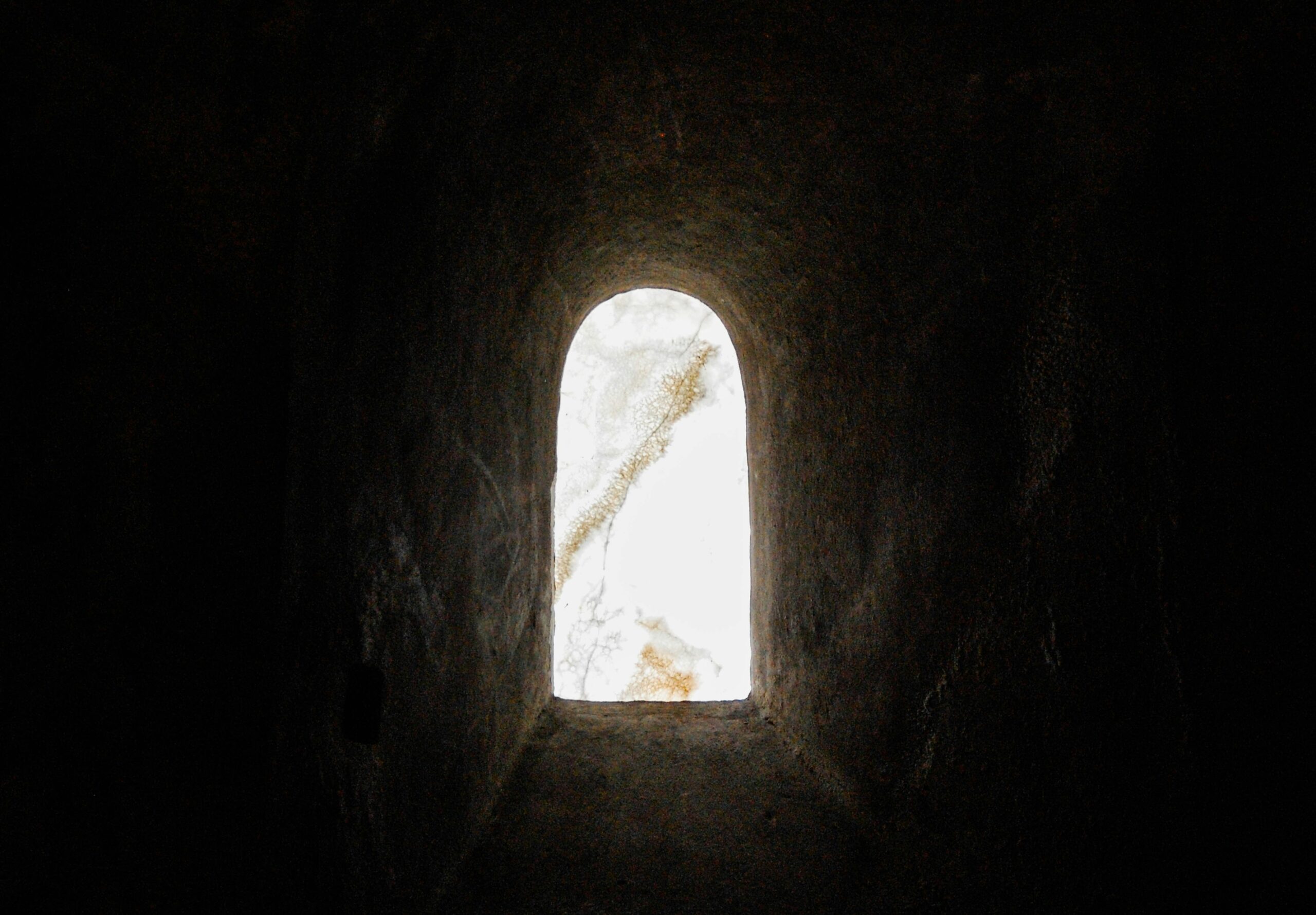Please turn with me in your bibles to Leviticus chapter 16. Leviticus chapter 16. That’s the third book of the bible, and really the center of the entire TORAH, or the books of Moses, the Law of Israel.
Tonight, I will attempt to make explicit several connections from the Old Testament to the New, from the ceremonies of Israel and the Cross, from the priestly work in the tabernacle to Christ’s priestly work at Calvary.
Leviticus 16 contains the instructions from God himself, given to Moses, concerning the Day of Atonement. This was the holiest day of the Jewish religious calendar. It is the day on which annual atonement is made for the sins of the entire nation of Israel.
Verses 4 & 5 of chapter 16 explain that the ceremonial day begins with the priest being dressed in the appropriate attire. He must first bathe himself to ensure no impurity remains upon his body. He then dons the garments and a coat, both made of fine linen, with a linen sash around his waist, and a linen turban upon his head. Then in verse 6, Moses explains that the priest must then take a bull and sacrifice it as a sin offering for himself and his whole house. This procedure is explained in detail from verses 11-14.
But what I’d like to focus our attention on is what the priest then does for the nation of Israel, for the people of God. It is in this work as priest, as mediator to God on behalf of the people, that we see very clear connections to Jesus. Let’s read Leviticus 16, verses 15-19:
15 “Then he shall kill the goat of the sin offering that is for the people and bring its blood inside the veil and do with its blood as he did with the blood of the bull, sprinkling it over the mercy seat and in front of the mercy seat. 16 Thus he shall make atonement for the Holy Place, because of the uncleannesses of the people of Israel and because of their transgressions, all their sins. And so he shall do for the tent of meeting, which dwells with them in the midst of their uncleannesses. 17 No one may be in the tent of meeting from the time he enters to make atonement in the Holy Place until he comes out and has made atonement for himself and for his house and for all the assembly of Israel.18 Then he shall go out to the altar that is before the Lord and make atonement for it, and shall take some of the blood of the bull and some of the blood of the goat, and put it on the horns of the altar all around. 19 And he shall sprinkle some of the blood on it with his finger seven times, and cleanse it and consecrate it from the uncleannesses of the people of Israel.
Let’s make several observations from this priestly work on behalf of the nation. Aaron first kills the sin-offering brought by the people. He enters into the holy of holies, the most sacred part of the tabernacle, the part of the tabernacle so sacred that he alone can enter it only once a year, and he sprinkles the blood.
The text says he sprinkles it ON the mercy seat, and before, or in front of and around the mercy seat, thus filling the holy of holies with atoning blood. The blood there is proclaiming both substitution and cleansing.
Substitution, because we see the life of an innocent one shed so that the guilty nation might be spared. The life of the living one shed so that the guilty ones, the ones that would otherwise be under the sentence of death, could be forgiven.
This image clearly points us to the greater substitute to come, the substitute that the New Testament reveals as Jesus Christ. Christ’s blood was shed in the place of his people. He is the lamb of God who takes away the sins of the world through the shedding of his blood, just like the sin offering that Aaron would give in the place of the nation of sinners. That’s why Isaiah will say of him: “he was pierced for OUR transgressions; he was crushed for OUR iniquities” (53:5).
But this priestly work in the holy of holies, this sprinkling of blood also speaks to cleansing. It speaks to purification. That’s what was happening in the Tabernacle. The nation of Israel had polluted the place, polluted themselves, and even polluted the Tabernacle. But, by the sacrifice of another in their place, and through the shedding of innocent blood, the place could be made pure again. The pollution could be cleansed.
That’s the same work that is attributed to Christ in the New Testament. Hebrews 9 speaks of Christ’s work as our great high priest:
11 But when Christ appeared as a high priest of the good things that have come… 12 he entered once for all into the holy places, not by means of the blood of goats and calves but by means of HIS OWN BLOOD, thus securing an eternal redemption.
Christ’s work, specifically Christ’s blood, is that means of securing an eternal redemption. His death on the cross is that substitutionary and cleansing offering made on behalf of a sinful nation in order to purify them. Again, to cite Isaiah: “By his stripes, we are healed…because the Lord has laid upon him the iniquity of us all” (53:5-6).
To make the connection even more explicit, we can go back to Leviticus and note the specific language used. The place where Aaron was to sprinkle the blood was both on and around the Mercy Seat. Mercy Seat could be literally translated the “atonement covering.” It was a slab of pure gold, the most valuable substance, and served as a lid to the ark of the covenant. This was to be the place where God specially reveals his presence, right above the ark, right above where Aaron sprinkled the blood.
The ark contains the two stone tables of the ten commandments, the ones that God wrote with his very own fingers, which represents the moral obligations of the Covenant. All mankind has transgressed those commandments, and especially the Israelites, and thus the sprinkling of the Mercy seat was the picture of the covering of their covenantal transgressions by the blood of an innocent one. This golden, but blood-smeared cover was a picture of atonement, of cleansing, of substitution, and this all took place on the mercy seat.
With that in mind, hold your finger here in Leviticus and turn in your bibles to Romans chapter 3. Romans chapter 3. We’ll begin at the well-known verse 23 but keep reading and see a wonderful and explicit connection to this priestly work from Leviticus. Romans 3:23:
23 for all have sinned and fall short of the glory of God, 24 and are justified by his grace as a gift, through the redemption that is in Christ Jesus, 25 whom God put forward as a propitiation by his blood, to be received by faith.
The word we need to see here is translated “propitiation” in verse 25 in my translation. That word is HILASTERION, which is the same word used in the Greek translation of Leviticus 16 for Mercy Seat. What Paul is saying is that Christ’s redemptive work, his work on the cross, has become for us the final and perfect mercy seat atonement. His LIFE is the substitution we need for our sentence of death to be removed, and his blood was the cleansing sprinkling that we need to be made pure. He is our HILASTERION, Christ is our mercy seat.
All of this, all of Leviticus 16, all of the intricate ritual and the bloody sacrifices, all of it pointed to the coming perfect and final sacrifice made by Jesus Christ. Christ is our sin offering, Christ is our purification offering, Christ is our way to be made clean, Christ is our very mercy seat.
These pictures, these shadows from Leviticus, fill out for us the multi-faceted nature of Christ’s atoning work. We’re given greater depth of vision, greater clarity about the nature of his priestly and sacrificial role, and these realities are what we celebrate tonight on Good Friday. Christ is our Mercy seat, and because of that, we have HIS death substituted in the place of our own, and we have HIS BLOOD shed for our purification.
Praise be to God.
But there’s more gold to be mined back in Leviticus 16. Let’s go back to Leviticus 16 and begin reading again in verse 20.
20 “And when he has made an end of atoning for the Holy Place and the tent of meeting and the altar, he shall present the live goat. 21 And Aaron shall lay both his hands on the head of the live goat, and confess over [the goat] all the iniquities of the people of Israel, and all their transgressions, all their sins. And he shall put them [that is, the sins] on the head of the goat and send it away into the wilderness by the hand of a man who is in readiness. 22 The goat shall bear all their iniquities on itself to a remote area, and he shall let the goat go free in the wilderness.
After having made the sin offering inside the Holy Place with the blood of the slaughtered goat, Aaron would then typify atonement in another way. He would take a second goat, a spotless and unblemished goat given from among the nation of Israel, and he would lay both hands upon its head. And all the people could hear him confess the iniquities and sins of the nation.
In what was surely a solemn occasion, Aaron would thus symbolically transfer all of the sinfulness, all of the guilt, all of the impurity, all of the defilement from the people of God, and onto this scape-goat.
Then, having confessed the sins and laid them on the head of this goat, the goat thus stood alone, laden with the curse. Bearing the weight of the curse of sin. And a man would come and lead the goat out, outside of the tabernacle of God’s presence, outside of the camp of fellowship with God’s people, outside of protection and communion, and into the barren, lonely, dangerous wilderness. It was led to its death.
The wrath against the sins of Israel will now land upon this lonely creature in the desert, rather than landing upon the people of God. Thus, the removal of sin and the curse was pictured.
But this is not the last time in scripture that such a transfer of guilt and removal of sin was done. Christ himself is pictured as our scapegoat in the New Testament.
Hebrews 13:11-12 speaks to this reality when it says,
11 For the bodies of those animals whose blood is brought into the holy places by the high priest as a sacrifice for sin are burned outside the camp. 12 So Jesus also suffered outside the gate in order to sanctify the people through his own blood.
Hebrews is saying that Christ was our scapegoat. Just like Aaron put his hands upon the head of the goat and transferred the guilt of sin and the curse, so too did Christ bear the very image of the curse, thorns, upon his own head. He bore the wrath of the curse that was earned by us. He carried the sins that we had committed. Paul tells us in 2nd Corinthians 5:21 that God made Jesus, who knew no sin (just like the innocent scape-goat), to be sin, so that in him we might be made righteous. Christ was our scapegoat.
Christ also suffered and died outside the gate, just like the scapegoat. He was led outside of the gates of Jerusalem, and the sins of a sinful nation were transferred to him. Just like the goat, he was led outside of the place of God’s special presence in the temple, outside of the safety and protection of the camp, left to suffer and die alone. All of this was done by Christ in our place.
He suffered outside, so that we might have access to God’s sacred presence. He was forsaken by God, so that we might have the veil torn down, the veil separating us from God’s presence in the most holy place.
Because he was our scapegoat, we can now have access to God. Our high priest has finally and forever completed his work of atonement, forever opened up access for us to enter into God’s presence, and forever taken the curse and guilt from us.
This is the good news of the gospel, that he bore upon his head the guilt that we deserved, thereby destroying the curse of death that hung upon our heads.
Believers, be encouraged this night by reflecting upon the scapegoat. The goat took the sins and guilt of the people of God and carried them out of the camp, never to be seen again, never to be mentioned or brought against them again.
So too has Christ borne your sin and removed it from you. You’re no longer guilty, defiled and impure. You’re no longer crushed under the weight of the curse. You’re no longer unable to have access to God. You’re no longer in Adam, who himself was cast out of God’s presence in the garden, but you instead have Christ as your new head, forever securing your ability to dwell with God.
Praise be to Christ, our mercy seat of substitution and cleansing, and our great scapegoat of purification and forgiveness.
And if you have not yet tasted of this forgiveness, if you’re still guilty, marred by sin, unable to enter God’s holy presence because of your defilement, then hear of this great sacrifice that was made. Know that this offer of forgiveness and atonement is available to you, if you but come and believe.
Believe in this Christ. Believe in this glorious high priest. Believe in his atoning work. Believe that he really was the propitiation made for our sins and the sacrifice made for our cleansing.
For if you believe, you too can celebrate the forgiveness of sins, the cleansing of a defiled conscience, and the rest that can only come by knowing that your sins have been removed as far as the east is from the rest by our great scapegoat who was led out of the camp in our place.
Amen.



